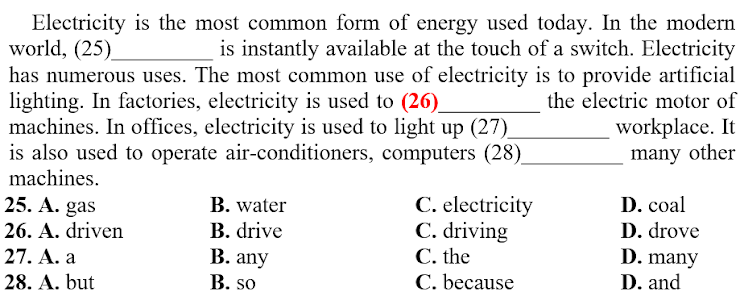I. READING Read the following passage and mark the letter A, B, C, or D on your answer sheet to indicate the correct word or phrase that best fits each of the numbered blanks The country and the city have advantages and disadvantages. People in the country live in more beautiful surroundings. They enjoy (19) …………….. and quietness, and can do their work at their own pace because no one is in a (20) …………………... They live in larger, more comfortable houses, and their neighbors are more friendly,...
Đọc tiếp
I. READING Read the following passage and mark the letter A, B, C, or D on your answer sheet to indicate the correct word or phrase that best fits each of the numbered blanks
The country and the city have advantages and disadvantages. People in the country live in more beautiful surroundings. They enjoy (19) …………….. and quietness, and can do their work at their own pace because no one is in a (20) …………………... They live in larger, more comfortable houses, and their neighbors are more friendly, and ready to help them (21) ……………….. they need it. Their life, however, can be boring and they may be isolated, which is serious problem (22) ……………… they are ill or want to take children to school. The city has all the services that the country lacks, but it also has a lot of disadvantages. Cities are often polluted. They not only have polluted air but also have noisy streets. Everyone is always in hurry and this means that people have no time to get to know each other and make friends.
Question 19. A. quietly B. peaceful C. peace D. quiet
Question 20. A. hurried B. hurrying C. hurriedly D. hurry
Question 21. A. what B. when C. which D. that
Question 22. A. unless B. although C. because D. if
Read the following passage and mark the letter A, B, C, or D on your answer sheet to indicate the correct answer to each of the questions
The country is more beautiful than a town and more pleasant to live in. Many people think so, and go to the country for the summer holidays though they cannot live there all the year round. Some have a cottage built in a village so that they can go there whenever they can find the time. English villages are not all alike, but in some ways they are not very different from one another. Almost every village has a church, the round or square tower of which can be seen from many miles around. Surrounding the church is the church yard, where people are buried. The village green is a wide stretch of grass, and houses or cottages are built round it. Country life is now fairly comfortable and many villages have running water brought through pipes into each house. Most villages are so close to some small towns that people can go there to buy what they can’t find in the village shops.
Question 23. When do city people often go to the country?
A. At the weekends.
B. All the year round.
C. At Christmas.
D. . The summer holidays.
Question 24. What is the advantage of city people when they have a cottage built in the
village?
A. They can have their houses rented.
B. They can go to the country at weekends.
C. They can go to the country when they are busy.
D. They can go to the country whenever they can find the time.
Question 25. What is NOT mentioned in the life of English villages?
A. The village green
B. Running water
C. The church
D. The Internet
Question 26. What can villagers do when their villages are close to small towns?
A. They can go there to buy cheaper things.
B. They can go there to buy whatever they want.
C. They can go there to buy luxury goods.
D. They can go there to buy what is not found in the village shops.


Chọn đáp án A
Giải thích: đáy của dòng suối càng ngày càng sâu => nên tạo ra thung lũng
A. sau đó
B. trong khi đó
C. giữa
D. ở trong
Dịch bài đọc:
Gió, nước, không khí, băng và nhiệt đều hoạt động để gây xói mòn. Khi gió thổi qua vùng đất, nó thường nhặt những hạt cát nhỏ. Khi những hạt cát tấn công vào những tảng đá rắn, những tảng đá đang dần mòn đi. Bằng cách này, các sườn đồi rất cứng đá bị mòn bởi gió.
Khi các hạt đá hoặc đất bị nới lỏng theo bất kỳ cách nào, nước chảy sẽ đưa chúng xuống sườn đồi. Một số đá và hạt đất được đưa vào suối và sau đó xuống biển.
Đất bị che phủ bởi cây cối, cỏ và các loại cây khác mòn rất chậm, và vì vậy mất rất ít đất. Rễ cây giúp giữ cho đá và đất tại chỗ. Nước rơi trên đồng cỏ chạy chậm hơn so với nước rơi trên mặt đất trống. Vì vậy, rừng và đồng cỏ giúp làm chậm sự xói mòn.
Ngay cả khi đất được bao phủ bởi cây cối, một số xói mòn vẫn tiếp diễn. Vào mùa xuân, tuyết nóng chảy biến thành một lượng lớn nước sau đó chảy xuống dưới suối. Khi một dòng suối mang đi một số đất, lòng suối càng ngày càng trở nên tan chảy sâu hơn hàng ngàn năm như vậy, các thung lũng rộng thường được hình thành.